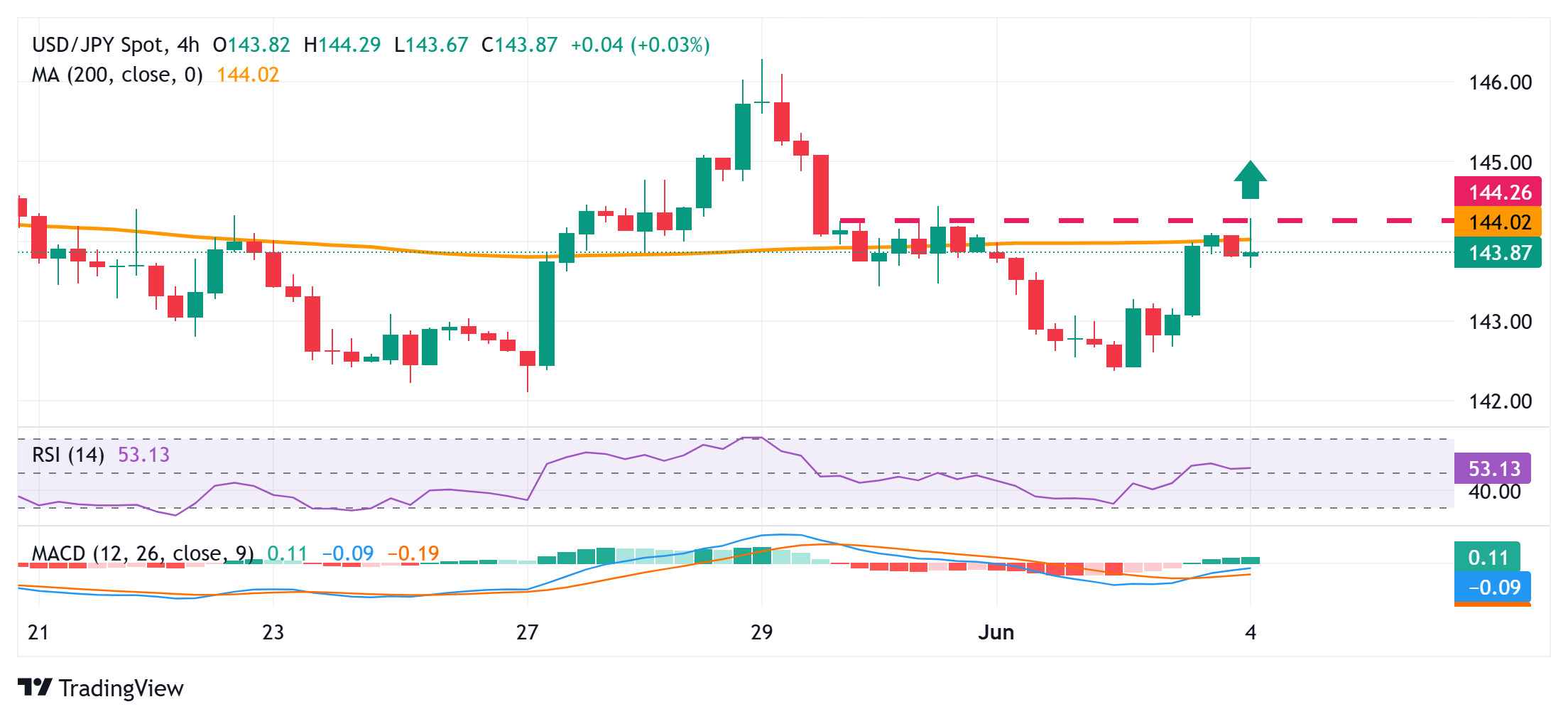- The Japanese Yen drifts lower for the second consecutive day against a mildly positive USD.
- An upward revision of Japan’s Services PMI lifts BoJ rate hike bets and favors the JPY bulls.
- Safe-haven buying could further benefit the JPY amid the divergent BoJ-Fed expectations.
The Japanese Yen (JPY) remains on the back foot against its American counterpart for the second straight day and touches a fresh weekly low during the Asian session on Wednesday. Bank of Japan (BoJ) Governor Kazuo Ueda’s cautious remarks on Tuesday fueled speculations that the next interest rate hike won’t come soon. Adding to this calls for the BoJ to slow tapering beyond 2026 and a generally positive risk tone turn out to be key factors undermining the safe-haven JPY. Furthermore, a modest US Dollar (USD) uptick lifts the USD/JPY pair to the 144.30 area in the last hour.
Any meaningful JPY depreciation, however, seems elusive amid the growing acceptance that the BoJ will continue raising rates this year. The bets were reaffirmed by an upward revision of Japan’s Services PMI, which, along with expectations that higher wages will boost inflation, backs the case for a further BoJ policy normalization. Nevertheless, this marks a big divergence in comparison to the market pricing that the Federal Reserve (Fed) will lower borrowing costs further in 2025. This might cap the USD and limit losses for the lower-yielding JPY amid geopolitical risks and trade uncertainties.
Japanese Yen is undermined by reduced bets for an immediate BoJ rate hike
- A private sector survey showed on Wednesday that growth in Japan’s service-sector activity slowed less than estimated in May. The final au Jibun Bank Japan Services Purchasing Managers’ Index (PMI) was revised from a 50.8 flash reading to 51.0. This was below the previous month’s final print of 52.4, though it signaled a second consecutive expansion in services activity.
- The data keeps hopes for another interest rate hike by the Bank of Japan (BoJ) during the second half of the year and provides a modest lift to the Japanese Yen during the Asian session. Meanwhile, BoJ Governor Kazuo Ueda sounded cautious on Tuesday and said in the parliament that uncertainties over overseas trade policies, economic and price situations remain extremely high.
- Ueda added that there is no preset plan for rate hikes and that he won’t push for higher interest rates unless the economy is strong enough to take it. Moreover, reports that Japan’s Prime Minister Shigeru Ishiba may dissolve parliament for a snap general election if the main opposition party submits a no-confidence motion, might cap any further gains for the JPY.
- The US Dollar struggles to capitalize on the previous day’s recovery from the lowest level since April 22 amid the growing acceptance that the Federal Reserve (Fed) will lower borrowing costs further by the end of this year. Adding to this concerns about the worsening US fiscal situation and the economic fallout from trade tariffs keep the USD bulls on the defensive.
- The increase in steel and aluminum import tariffs from 25% to 50% will be effective from Wednesday. Meanwhile, several White House officials said in recent days that US President Donald Trump and Chinese President Xi Jinping will hold a call this week, likely on Friday, which could help to revitalize trade negotiations between the world’s two largest economies.
- On the economic data front, the US Bureau of Labor Statistics (BLS) reported in the Job Openings and Labor Turnover Survey (JOLTS) on Tuesday that showed that the number of job openings on the last business day of April stood at 7.39 million. This reading followed the 7.2 million openings recorded in March and came in above the market expectation of 7.1 million.
- Traders now look forward to the release of the ADP report on US private-sector employment for some impetus in the run-up to the crucial US Nonfarm Payrolls (NFP) report on Friday. Wednesday’s US economic docket also features the release of the ISM Services PMI, which should influence the USD price dynamics and provide short-term impetus to the USD/JPY pair.
USD/JPY bulls might now aim towards reclaiming the 145.00 psychological mark

Technical indicators on the daily chart have been recovering and have just started gaining positive traction on the 4-hour chart. This, in turn, favors the USD/JPY bulls, though an intraday failure to find acceptance above the 200-period Simple Moving Average (SMA) warrants some caution. Hence, it will be prudent to wait for some follow-through buying beyond the Asian session peak, around the 144.30 area before positioning for any further appreciating move. Spot prices might then aim to reclaim the 145.00 psychological mark, with some intermediate hurdle near the 144.75-144.80 region.
On the flip side, the 143.50-143.45 area now seems to act as immediate support, below which the USD/JPY pair could slide to the 143.00 round figure. Follow-through selling would drag spot prices to the 142.40-142.35 region, or the weekly trough set on Tuesday, en route to the 142.10 area, or the May monthly swing low touched last week.
Japanese Yen FAQs
The Japanese Yen (JPY) is one of the world’s most traded currencies. Its value is broadly determined by the performance of the Japanese economy, but more specifically by the Bank of Japan’s policy, the differential between Japanese and US bond yields, or risk sentiment among traders, among other factors.
One of the Bank of Japan’s mandates is currency control, so its moves are key for the Yen. The BoJ has directly intervened in currency markets sometimes, generally to lower the value of the Yen, although it refrains from doing it often due to political concerns of its main trading partners. The BoJ ultra-loose monetary policy between 2013 and 2024 caused the Yen to depreciate against its main currency peers due to an increasing policy divergence between the Bank of Japan and other main central banks. More recently, the gradually unwinding of this ultra-loose policy has given some support to the Yen.
Over the last decade, the BoJ’s stance of sticking to ultra-loose monetary policy has led to a widening policy divergence with other central banks, particularly with the US Federal Reserve. This supported a widening of the differential between the 10-year US and Japanese bonds, which favored the US Dollar against the Japanese Yen. The BoJ decision in 2024 to gradually abandon the ultra-loose policy, coupled with interest-rate cuts in other major central banks, is narrowing this differential.
The Japanese Yen is often seen as a safe-haven investment. This means that in times of market stress, investors are more likely to put their money in the Japanese currency due to its supposed reliability and stability. Turbulent times are likely to strengthen the Yen’s value against other currencies seen as more risky to invest in.

